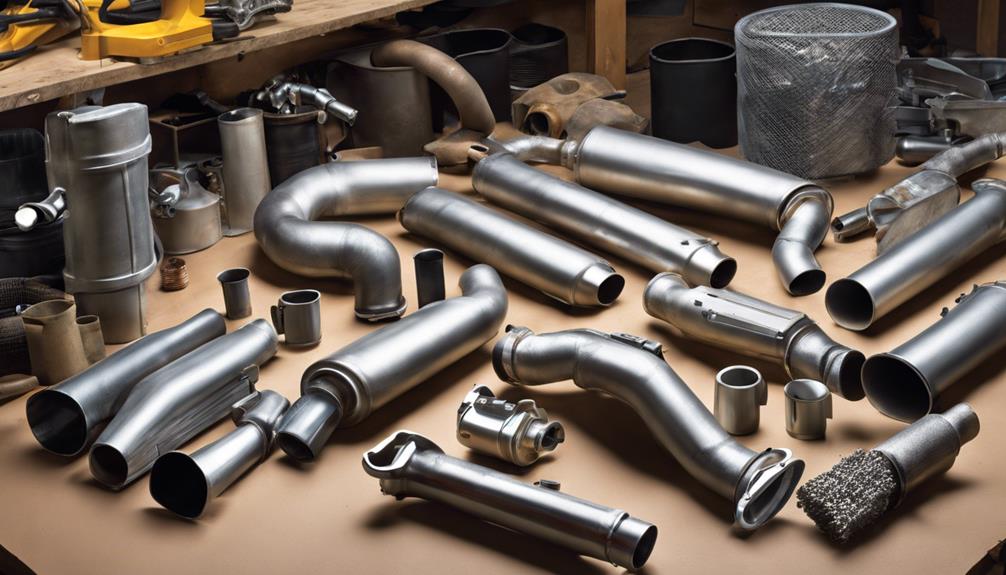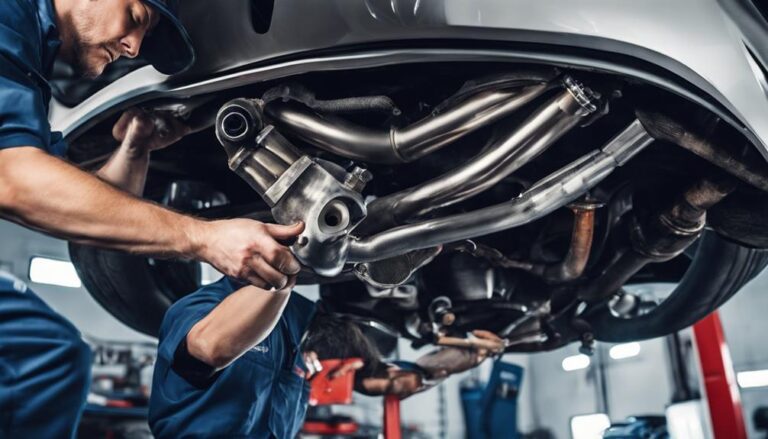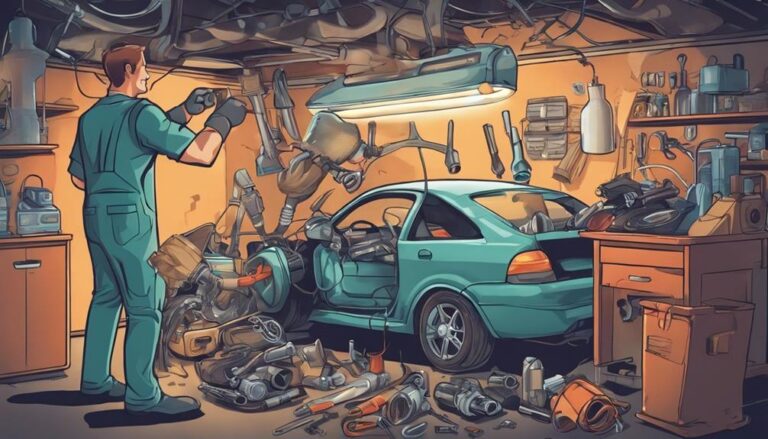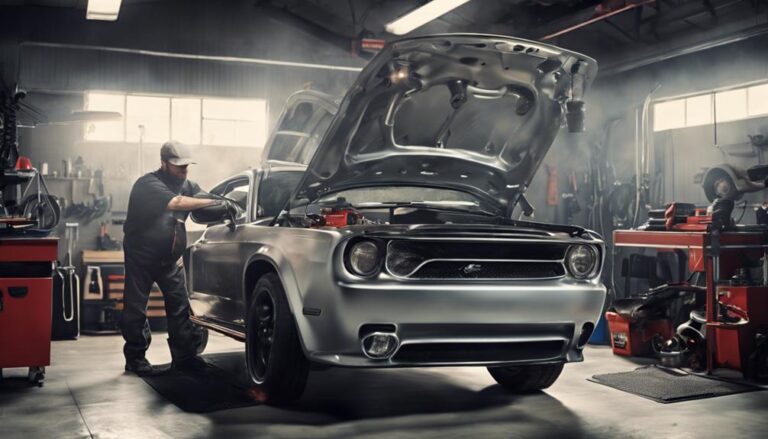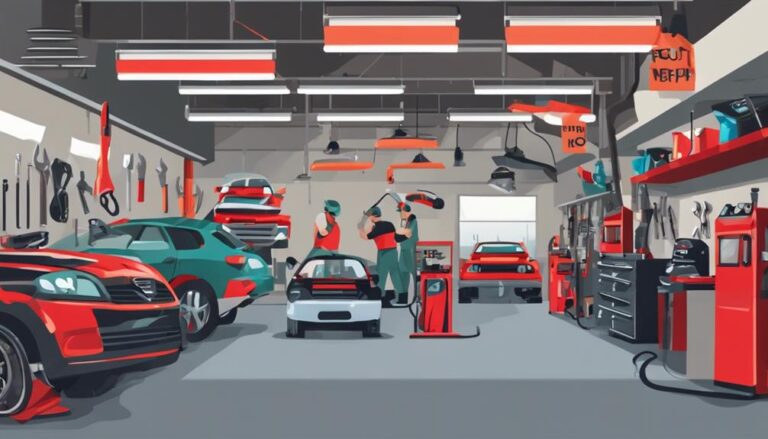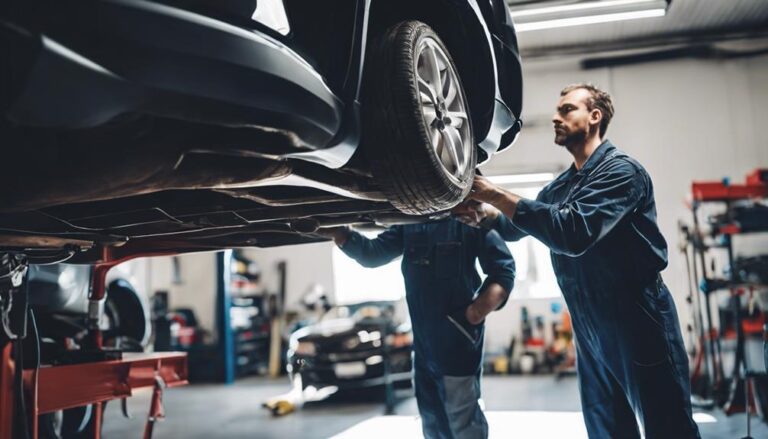10 Best Exhaust System Components for Car Repairs
When it comes to fine-tuning your car's performance, think of the exhaust system components as the orchestra members harmonizing to create a symphony of efficient power.
But which components truly stand out among the rest? From the crucial exhaust manifold to the subtle exhaust tips, each plays a vital role in maintaining your vehicle's health.
But what makes them the best, and how can they elevate your driving experience to a new level? Let's explore the top 10 exhaust system components that could make a difference in your car repairs, offering not just functionality but a touch of excellence.
Key Takeaways
- Exhaust emission control components are vital for engine performance and emissions regulation.
- Regular maintenance of particulate filtration systems ensures optimal function and reduced emissions.
- Upgrading to performance enhancers like headers and mufflers can boost horsepower and optimize exhaust flow.
- Sound modification components like resonators and tips allow for personalized sound and visual enhancements in the exhaust system.
Exhaust Manifold
When repairing a car's exhaust system, the exhaust manifold plays a vital role in collecting and directing exhaust gases from each cylinder towards emission control components. The material of the exhaust manifold, commonly cast iron or steel, is crucial for its performance. These materials offer durability and heat resistance, ensuring that the manifold can withstand high temperatures and harsh conditions.
The installation of the exhaust manifold provides benefits such as improving engine performance and fuel efficiency. By efficiently collecting exhaust gases from the cylinders, the manifold helps reduce back pressure, allowing the engine to breathe better and operate more smoothly. Additionally, a properly installed exhaust manifold ensures that exhaust gases are effectively directed towards the emission control components, aiding in reducing harmful emissions.
Oxygen Sensor
The oxygen sensor is a vital component of your vehicle's exhaust system. It continuously monitors and analyzes the oxygen levels in the exhaust gases. By providing real-time feedback to the engine control unit, it helps maintain the ideal air-fuel ratio for efficient combustion.
Proper maintenance of the oxygen sensor is essential to ensure optimal engine performance, reduce emissions, and prevent costly repairs down the line.
Importance of Oxygen Sensor
To ensure optimal engine performance and emissions control, the oxygen sensor plays a critical role in monitoring and adjusting the air-fuel ratio in the exhaust system. Oxygen sensors measure oxygen levels in the exhaust, aiding the engine in adjusting the fuel mixture for peak performance while reducing emissions. They are vital for the catalytic converter to function effectively by providing data on the air-fuel ratio. Modern vehicles come equipped with one or more oxygen sensors to monitor and maintain the correct air-fuel ratio, enhancing overall engine performance. Faulty sensors can lead to decreased fuel efficiency, increased emissions, and potential catalytic converter damage. Regular maintenance and timely replacement of oxygen sensors are essential for smooth engine operation and complying with emissions regulations.
| Benefits | Troubleshooting |
|---|---|
| Optimal engine performance | Check engine light comes on |
| Reduced emissions | Poor fuel efficiency |
| Improved fuel efficiency | High emissions readings |
Maintenance Tips
For optimal engine performance and emissions control, maintaining proper functioning of the oxygen sensor is crucial. Regular maintenance of the oxygen sensor is essential to avoid common issues in the exhaust system, such as decreased fuel efficiency and increased emissions.
By troubleshooting and addressing any issues promptly, you can prevent potential damage to the catalytic converter. Replacing oxygen sensors every 60,000 to 90,000 miles can lead to significant benefits, including improved engine efficiency and emission compliance, ultimately resulting in cost savings in the long run.
Modern vehicles may have multiple oxygen sensors strategically placed in the exhaust system. Proper maintenance of these sensors is a relatively straightforward task that can enhance overall engine performance and longevity.
Catalytic Converter
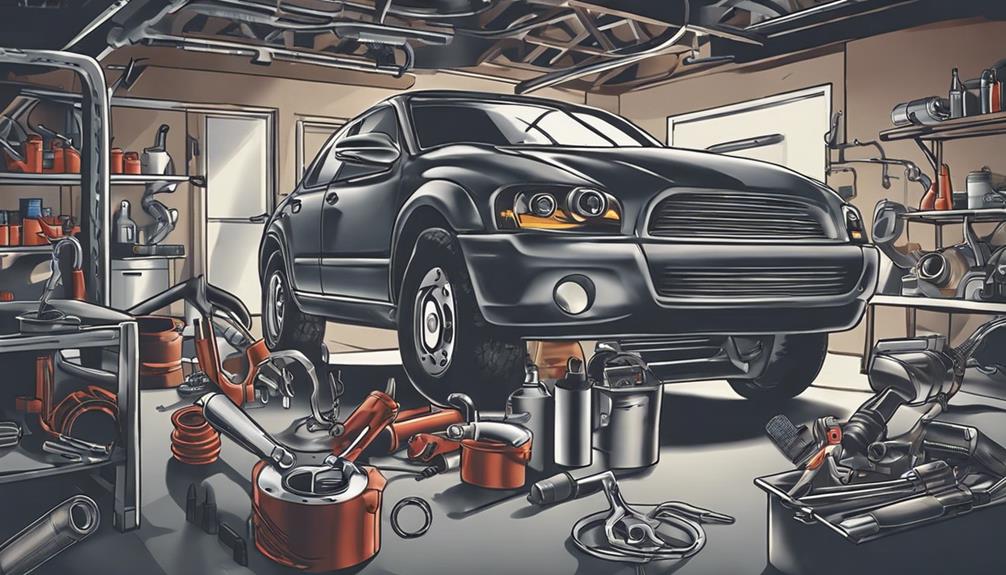
Efficiently converting harmful gases into less toxic emissions, the catalytic converter is a vital component in modern vehicle exhaust systems. These devices play a crucial role in reducing nitrogen oxides, carbon monoxide, and hydrocarbons, transforming them into less harmful substances. The converter's honeycomb-like structure provides a large surface area for the chemical reactions necessary to diminish pollutants. Additionally, many catalytic converters now integrate a lambda sensor to monitor and optimize the emissions conversion process continuously.
To highlight the importance of catalytic converter efficiency, consider the following table:
| Aspect | Description |
|---|---|
| Efficiency | Converts toxic gases into less harmful emissions effectively |
| Lambda Sensor Integration | Monitors and optimizes the emissions conversion process continuously |
| Environmental Compliance | Crucial for meeting regulations and reducing vehicle emissions |
Diesel Particulate Filter (DPF)
The Diesel Particulate Filter (DPF) is a crucial component in diesel vehicles, designed to trap harmful particles and reduce emissions.
Understanding the functionality, maintenance tips, and replacement procedures for the DPF is essential for optimizing its performance and longevity.
Proper care and attention to the DPF can ensure efficient operation and compliance with emission standards.
DPF Functionality Overview
To maintain optimal performance in diesel vehicles, understanding the Diesel Particulate Filter (DPF) functionality is essential. The DPF traps harmful particles like soot to reduce emissions, utilizing mesh or honeycomb screens.
Here are three key points to deepen your understanding:
- Regeneration Process: Periodically, the DPF initiates a regeneration process to burn off trapped particles, preventing blockages and ensuring efficient operation.
- Forced Regeneration: In case of blockages, diesel cars may require a forced regeneration to maintain the DPF's effectiveness.
- Gasoline Particulate Filters: Petrol engines equipped with OPF/GPF systems help prevent clogging similar to DPFs in diesel vehicles.
Understanding these aspects of DPF functionality is crucial for emission control and optimal engine performance.
DPF Maintenance Tips
For optimal performance and longevity of your diesel vehicle, maintaining the Diesel Particulate Filter (DPF) through proper care and regular maintenance is crucial. The DPF regeneration process is essential to burn off trapped particles and ensure efficiency, benefiting both your car's performance and the environment. Common DPF problems like blockages can be solved through forced regenerations, preventing costly repairs. Ensuring your DPF is functioning properly not only reduces harmful emissions but also avoids potential engine damage. Here's a breakdown of common DPF maintenance tips:
| DPF Maintenance Tips | Benefits |
|---|---|
| Regularly Regenerate DPF | Prevents Blockages |
| Use High-Quality Diesel Fuel | Enhances DPF Lifespan |
| Check Engine Light Alerts | Early Problem Detection |
| Avoid Short, Stop-Start Journeys | Facilitates Regeneration Process |
| Professional DPF Cleaning | Ensures Optimal Performance |
DPF Replacement Guide
Maintaining optimal performance and longevity for your diesel vehicle involves understanding the Diesel Particulate Filter (DPF) and knowing when it's time for a replacement. When facing DPF issues, consider the DPF regeneration process and various DPF cleaning methods to potentially restore functionality.
Recognizing DPF warning signs and utilizing DPF troubleshooting tips can aid in diagnosing problems early on. If replacement becomes necessary, be aware that costs can vary based on your vehicle type and the brand of DPF chosen. To ensure a proper installation, always seek guidance from a professional mechanic familiar with DPF systems.
Exhaust Muffler
One key component of a vehicle's exhaust system responsible for reducing noise generated during the combustion process is the exhaust muffler. Mufflers are crafted from sound-dampening materials and designed with chambers to diminish exhaust noise levels effectively. They're available in various designs such as chambered, straight-through, and turbo, each offering distinct sound characteristics.
The choice of muffler material and installation techniques can significantly impact noise reduction and overall performance. Moreover, mufflers play a crucial role in sound tuning, allowing for customized exhaust notes and enhancing the vehicle's performance. Quality mufflers not only attenuate noise but also optimize exhaust flow, which can lead to improved engine performance.
Upgrading to a high-performance muffler can further enhance both sound quality and the overall performance of your vehicle, making it a popular choice among enthusiasts seeking to liberate their car's true potential.
Exhaust Pipes
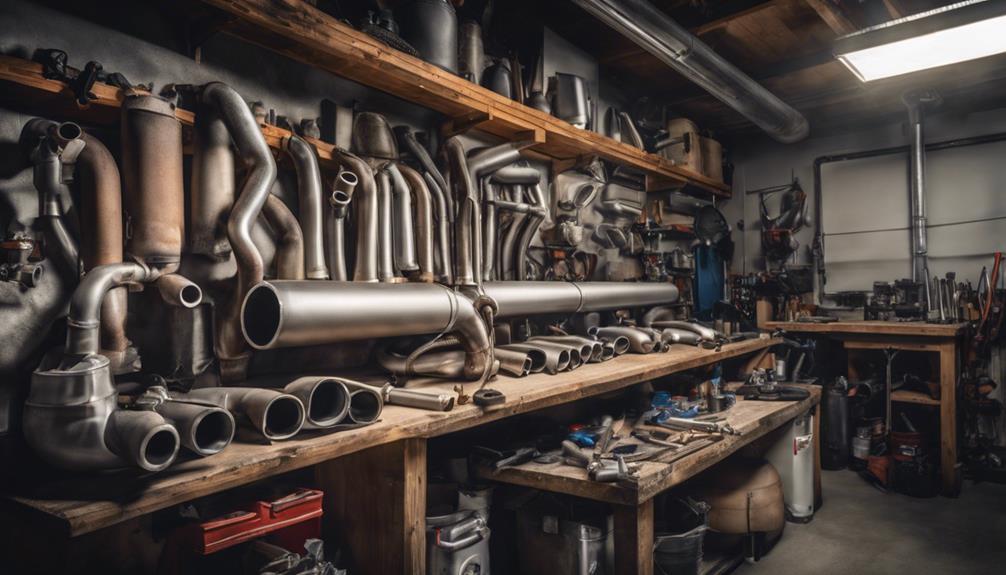
What materials are commonly used to manufacture exhaust pipes for optimal durability and performance?
Exhaust pipes are frequently crafted from stainless steel or aluminized steel due to their exceptional durability and resistance to corrosion. Mandrel-bent tubing is often incorporated in exhaust pipe construction to promote smooth airflow, thereby reducing back pressure and enhancing overall performance.
Additionally, custom exhaust pipe designs, such as single or dual exit configurations, can significantly influence the sound produced, the performance of the vehicle, and its visual appeal. By utilizing high-quality materials and innovative designs, exhaust pipes play a crucial role in ensuring efficient exhaust gas flow within the vehicle's system.
The various diameters available in exhaust pipes cater to different vehicle types and engine sizes, allowing for optimized performance of the exhaust system. These aspects collectively contribute to a more liberated driving experience, with enhanced durability, performance, and aesthetic appeal.
Headers
Enhancing engine performance through optimized exhaust flow, headers are crucial components that replace factory exhaust manifolds with individual tubes for each cylinder. By doing so, headers improve performance gains by reducing back pressure and increasing horsepower. Available in short and long tube designs, headers offer unique benefits for torque and power delivery. The installation process for headers varies depending on the make and model of the vehicle, but generally involves removing the old exhaust manifolds and fitting the new headers in place.
Headers with mandrel-bent tubing ensure smooth airflow, further enhancing engine efficiency. Upgrading to high-performance headers not only boosts horsepower but also contributes to a more aggressive exhaust note, adding to the overall driving experience. When considering modifications to improve your vehicle's performance, investing in quality headers can make a substantial difference. Whether you're looking for increased power or a more exhilarating sound, upgrading to high-performance headers is a step towards unlocking your car's true potential.
EGR Valve
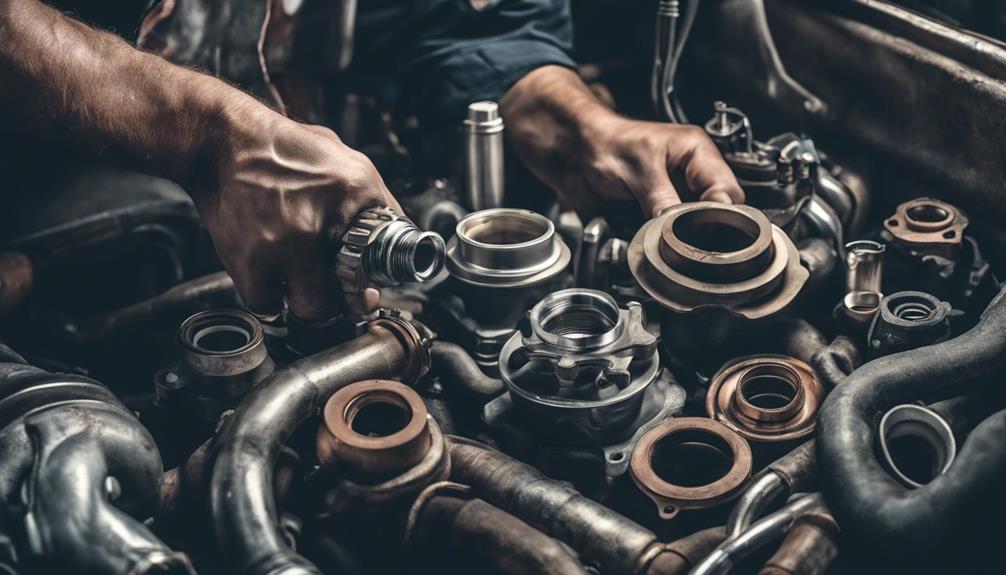
The EGR valve functions by recirculating a portion of exhaust gases to reduce nitrogen oxide emissions and lower combustion temperatures in internal combustion engines.
Regular maintenance and cleaning of the EGR valve are crucial for optimal engine performance and emissions control.
Neglecting EGR valve maintenance can lead to increased emissions, engine knocking, and decreased fuel efficiency.
EGR Valve Function
The function of the EGR valve, also known as the Exhaust Gas Recirculation valve, involves reducing nitrogen oxide emissions in internal combustion engines by recirculating a portion of exhaust gases back into the intake system.
When understanding the EGR valve benefits, consider that it helps lower combustion temperatures, reducing harmful nitrogen oxides (NOx) in the exhaust.
Moreover, the EGR valve troubleshooting may be necessary to ensure optimal engine performance and emission compliance.
Remember, maintaining an efficient EGR system not only enhances fuel economy but also plays a vital role in reducing emissions, contributing to a cleaner environment.
Regular inspection and upkeep of the EGR valve are crucial for both functionality and environmental responsibility.
EGR Valve Maintenance
Maintaining optimal performance of the EGR valve involves regular cleaning to remove carbon buildup and ensuring proper functionality to control emissions effectively.
When troubleshooting EGR valve issues, check for clogging or stuck mechanisms that hinder exhaust gas recirculation. Cleaning the valve and its passages can often resolve minor problems. However, if the valve is damaged beyond repair, replacement may be necessary.
EGR valve replacement costs vary depending on the make and model of the vehicle but typically range from $150 to $500, including parts and labor.
Ignoring EGR valve maintenance can lead to increased emissions, decreased fuel efficiency, and potential engine performance issues. Stay proactive in caring for your EGR valve to maintain optimal engine function and emission control.
Exhaust Resonator
Exhaust resonators function as acoustic chambers within the vehicle's exhaust system, altering the sound output to enhance the overall auditory experience. These components play a crucial role in fine-tuning the exhaust note to achieve the desired sound profile.
Here are some key points to consider about exhaust resonators:
- Resonator Design: The design of the resonator directly impacts its performance in modifying exhaust sound. Different shapes, sizes, and internal configurations can lead to varied sound outcomes.
- Sound Tuning: Exhaust resonators are essential for tuning the sound produced by the vehicle's exhaust system. They can help eliminate unpleasant frequencies and enhance the overall tone.
- Customization: Upgrading or customizing the exhaust resonator provides car owners with the flexibility to personalize their vehicle's sound. Whether aiming for a sportier growl or a more subdued tone, the resonator can be adjusted to meet specific preferences.
Exhaust Tips
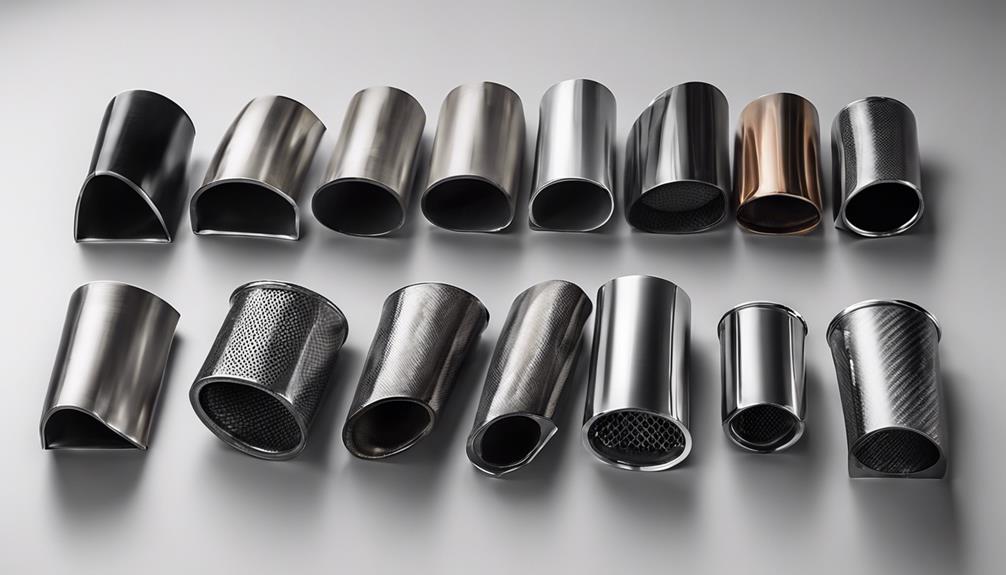
To enhance both the visual appeal and acoustics of your vehicle's exhaust system, exploring the realm of exhaust tips offers a practical and customizable solution. When considering exhaust tips, you can choose from various materials like stainless steel or carbon fiber, each offering durability against heat and corrosion. The design of the exhaust tips, whether rolled, angle-cut, or dual-wall, can significantly impact the overall appearance of your vehicle.
For those seeking to elevate their driving experience further, some exhaust tips come with built-in resonators that not only enhance the exhaust tone but also reduce drone for a more pleasant sound. Installing these tips is a straightforward and affordable way to personalize your exhaust system without the need for a complete replacement.
Exhaust Tips Comparison Table:
| Material | Design | Features |
|---|---|---|
| Stainless Steel | Rolled | Durable and classic look |
| Carbon Fiber | Angle-Cut | Lightweight and modern |
| Titanium | Dual-Wall | High-end finish and performance |
Explore the range of options available and select the exhaust tip that best suits your style and sound preferences.
Frequently Asked Questions
What Is the Best Replacement Exhaust System?
When looking for the best replacement exhaust system, consider performance upgrades and custom fabrication. Enhance your car's power and sound with leading brands like MagnaFlow, Borla, Corsa, Cherry Bomb, and Flowmaster. Your ride deserves the best.
What Is the Best Material for a Car Exhaust?
Stainless steel stands out as the top choice for car exhausts due to its unmatched durability and resistance to rust. Its longevity and performance make it the ideal material for ensuring your vehicle's reliability and efficiency.
What Is the Most Important Part of an Exhaust System?
When you look under the hood, the exhaust manifold stands out as the key player in the exhaust system. Its importance lies in directing emissions efficiently, enhancing performance, and avoiding leaks with proper maintenance.
What Is the Biggest Problem With a Broken Exhaust System?
When your exhaust system breaks, it becomes a costly repair and a safety hazard. Failing to address it promptly can lead to harmful emissions, loud noises, decreased fuel efficiency, and safety risks from rust or holes.
Conclusion
In conclusion, when it comes to car repairs, investing in high-quality exhaust system components can greatly improve vehicle performance and overall driving experience.
For example, replacing a worn-out catalytic converter with a new high-performance one can significantly reduce emissions and improve engine power, leading to better fuel efficiency and smoother operation.
Ensuring your exhaust system is in top condition is essential for maintaining your vehicle's optimal performance.

